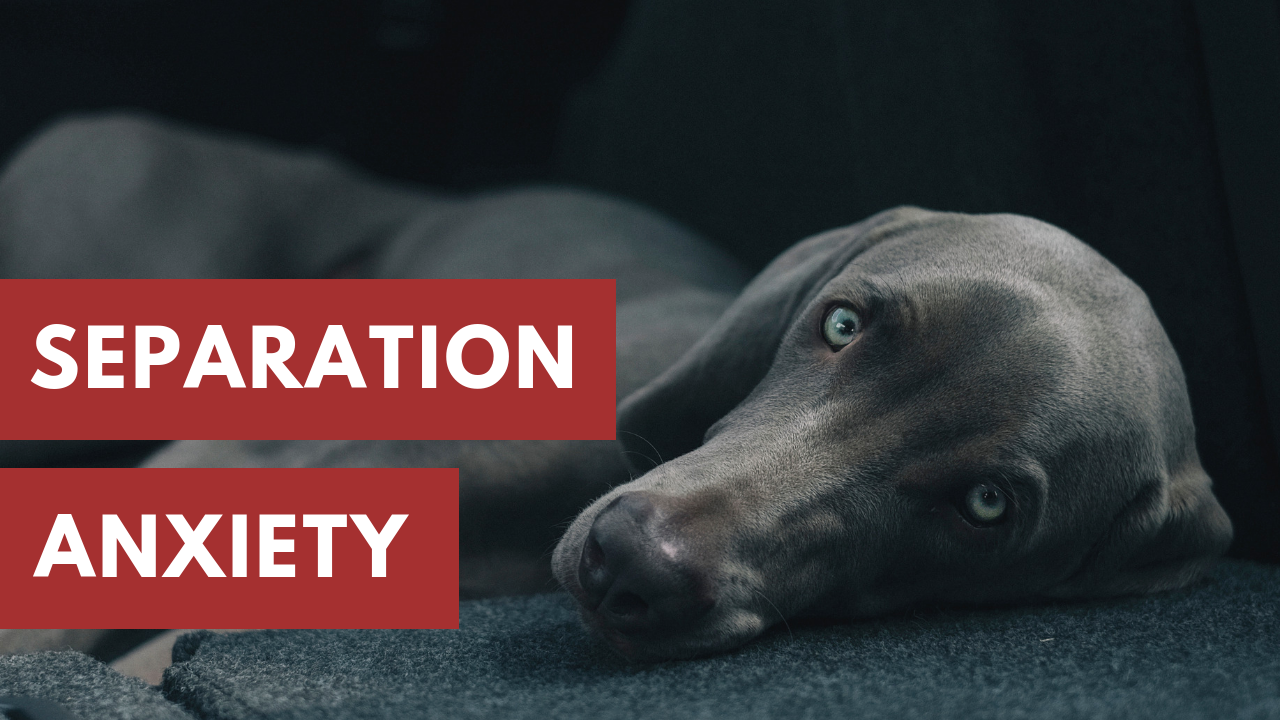Solving Your Dog’s Separation Anxiety
Why Does My Dog Have Separation Anxiety?

When a dog over-bonds to a person it is a multifaceted issue. Most over bonding issues start in puppy hood during the critical stage of development from 8 – 12 weeks. If your puppy isn’t socialized from 100 happy experiences with 100 or more people, your puppy is almost guaranteed to have behavioral problems when they mature into an adult dog.
But never fear! You can still teach your adult dog to get over their over bonding. However, if you are dedicated to helping your pet YOU will have a harder time making, and sticking to a new routine, than your dog. There is no one easy answer to solve your dog’s over bonding but some of the many contributing factors are listed below. Over bonding has similarities with Separation Anxiety.
How Dogs Learn Separation Anxiety:
Keep in mind that, most of the time, dog’s have multiple reasons why they’ve learned to over bond with people. Put quite simply, Separation Anxiety is taught to dogs. The good news is, thanks to humane and ethical behavior modification professionals, if your dog has learned to be dependent on you they can learn to be more independent away from you too.
Like other dog trainers in the Allentown PA area I see my fair share of difficult cases. The key to overcoming the issues you have with your dog is consistency. But you already knew that. What you don’t know is how to get your entire household on board so that your dog can succeed. If that is the case find a local fear free dog trainer through the Pet Professional Guild.
However, if the dog trainer you choose is good with dogs but not good with people you could be looking at an impossible case. Be careful with who you choose to help your companion.
Dogs develop problems because of:
- Low quality and infrequent socialization (often during critical development periods in puppyhood).
- Your dog sleeps with you in your bed.
- Your dog doesn’t know how to play with toys (many owners think this means their dog doesn’t like toys).
- Lack of ability to exercise vigorously.
- Not knowing how to trust other humans.
- You have too rigid a routine.
- Your routine changed suddenly (likely because it was too rigid originally).
- You are mostly gone for long periods, especially if you work most of the time.
- When you come home greetings are exciting and over-the-top.
- Your dog is not given a job to do (ditch the food bowl and look into food toys).
When I am helping a client my main focus is to have the family in the same room. Does that always happen? No. Spouses work night shifts, kids have soccer practice, and sometimes schedules are just difficult to juggle. That’s OK because I work with you and find a way, come hell or high water, to make progress with your pet dog.

Some signs that your dog could be over-bonded to you include:
- Your dog attacks strangers entering the house.
- They are constantly by your side and rarely leave you.
- Inability to be crate trained safely (your dog will hurt themselves when left in a crate).
- Cries or barks while you are gone and does nothing else.
- Inability to engage themselves in an activity without you such as self-play.
- Excessive scratching and pawing at the door you last left from.
- Runs frantically, urinates, and/or has destructive behaviors while you are away. (Soiling the house and destruction are also typical puppy behaviors. Make sure you use our free checklist to help your puppy move past these behaviors. )
- Guarding you from other dogs or people.
Taking Steps to Solve Separation Anxiety
There are different levels of separation anxiety in dogs. Some are easily managed while other are more extreme and a greater amount of effort needs to be made to see improvement. Contact a fear free dog training professional to get the most accurate diagnosis possible.

Some steps to help your dog recover from Separation Anxiety:
- Use a Kong food toy for every meal.
- Throw away your dog’s food bowl. Why? Contrafreeloading.
- Hire a dog walker.
- Get a remote treat trainer.
- Give your dog daily hard exercise.
- Avoid all heavy handedness.
- Avoid over exciting greetings.
- Greet your dog calmly and quietly for 5 seconds when coming home. Then walk away.
- Leave calmly and quietly while your dog is busy with a food toy.
- Teach them emotional control games (Stay, leave it, Settle Down, That’s enough).
- Potty Train your adult dog.
- Keep your dog safely confined (Doggy disneyland, bathroom, crate, small pen, baby gated room)
- Start a counter conditioning procedure
- Find the triggers that set your dog into panic mode.
- Perform one trigger at a time, completely randomly during the day so that they become desensitized.
- Start adding those triggers together, also completely randomly during the day.
- Make those triggers mean something else by giving a treat or working toy afterwards (the original Kong is a good choice).
- Avoid the long, anxious periods and invest in placing your dog in a daycare, with a pet sitter, drop them off at a friend’s house, confine them to a relaxing part of the house, or take them with you on trips (avoid leaving your dog in the car on even mildly warm days. Also check that your dog does not panic if they see you leave the car. This defeats the purpose of taking them with you.)
- Stay persistent.
When is it time to medicate?

Medication should be supplemental to behavioral treatment. There are some cases where immediate medication treatment should begin. However if your dog is causing extreme self-harming behaviors such as clawing until their paws bleed, chewing a crate until their gums bleed, or jumps through a pane of glass, it’s time to call in the medical professionals for immediate resolution.
Once you find the prescription that works for you and your dog it’s time to call the force free behavior expert. Medication is a supplement, not a crutch to rely on. It helps you to get where you need to go and should never be permanent.
If you find it difficult to get your family on-board with helping your dog overcome Separation Anxiety its time to call a force free and ethical dog training professional. While I primarily work out of the Lehigh Valley PA in Bucks, Montgomery, and Bethlehem township area I do Skype consults too! I can help you and your family any time, any where. Submit an inquiry here.
(c) Caitlin’s Animal Training Services 2018
www.CaitlinsAnimals.com

Pingback: Top 10 Ways to Tell Your Dog is Dominant ⋆ Caitlins Animal Training Services